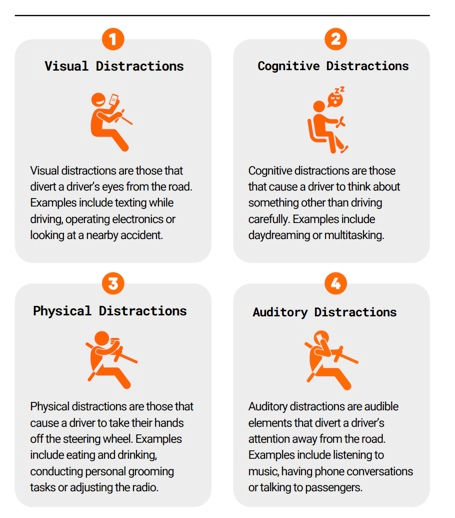Distracted Driving Prevention
- Tara McAllister
- Mar 27
- 2 min read

It is important to practice safe driving when commuting to work. Staying focused and avoiding distractions is essential for safety. The CDC defines distracted driving as any activity that diverts attention from the road, which can lead to severe consequences. The NHTSA reports nearly 400,000 injuries and 3,000 fatalities annually due to distracted driving.
Causes of Distracted Driving
Visual distractions—Such distractions involve taking your eyes off the road. Examples: reading emails or text messages, looking at maps or navigation systems and observing nearby activities (e.g., accidents, traffic stops or roadside attractions).
Manual distractions—These distractions cause you to remove your hands from the steering wheel. Examples: texting, adjusting the radio, programming navigation systems, eating, drinking or performing personal grooming tasks (e.g., applying makeup) while driving.
Cognitive distractions—Such distractions stem from thinking about something other than driving. Examples: focusing on vehicle passengers or daydreaming while driving.
Auditory distractions—These distractions are audible elements that divert your attention from the road. Examples: listening to loud music or talking on the phone while driving.

Understanding the Four Types of Driving Distractions: Visual, Cognitive, Physical, and Auditory. | Prevention of Distracted Driving: Tips and Advice |
Silence cell phone and place it in a secure spot out of reach to avoid checking it while driving.
Plan your trip ahead of time. Set up your navigation system before you start driving to familiarize yourself with your journey and feel confident about your route.
Choose music responsibly. Always keep the volume at a reasonable level.
Use in-vehicle technology such as hands-free devices, voice-activated controls, and telematics solutions.
Avoid multitasking. Do not perform additional tasks that may serve as a distraction while driving.
Stay focused. Keep your attention on the road by minimizing distracting conversations and looking straight ahead.
Maintain compliance. Ensure you follow all workplace policies and applicable local, state, and federal laws regarding distracted driving.
By encouraging safe driving habits, advocacy efforts help reduce these numbers and protect drivers, passengers, and pedestrians. Preventing distracted driving lowers financial costs related to medical expenses, vehicle repairs, and legal consequences. Promoting focused driving also fosters a culture of responsibility and accountability on the road, making travel safer for everyone!


Comments